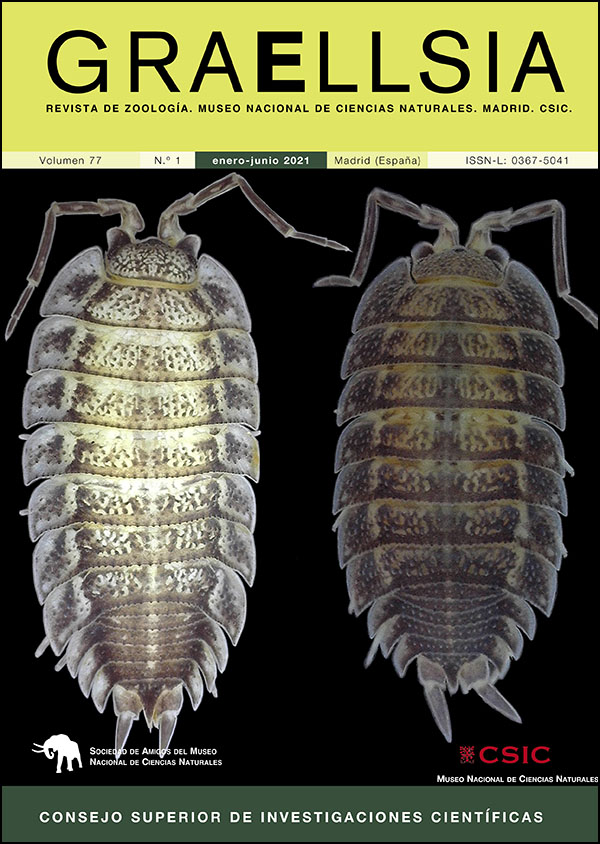Primera cita de Gordius albopunctatus Müller, 1927 en la Península Ibérica (Nematomorpha: Gordioida Rauther, 1930)
DOI:
https://doi.org/10.3989/graellsia.2021.v77.283Palabras clave:
Nematomorpha, Gordius, faunística, Madrid, España, península ibéricaResumen
Se hace referencia a la primera cita de Gordius albopunctatus Müller, 1927 (Gordioida) de la península ibérica, a partir de un ejemplar macho y otro hembra capturados en la Sierra de Guadarrama (Madrid). Esta cita es la más meridional de su distribución de modo que se amplía notablemente su distribución biogeográfica.
Descargas
Citas
Baker, G. H. 1985. Parasites of the millipede Ommatoiulus moreletii (Lucas) (Diplopoda: Iulidae) in Portugal, and their potential as biological control agents in Australia. Australian Journal of Zoology, 33: 23-32. https://doi.org/10.1071/ZO9850023
De Villalobos, L. C., Ribera, I. & Bilton, D. T. 2001. First data of Iberian Nematomorpha, with redescription of Gordius aquaticus Linnaeus, G. plicatulus Heinze, Gordionus wolterstorffii (Camerano) and Paragordius tricuspidatus (Dufour). Contributions to Zoology, 70: 73-84. https://doi.org/10.1163/18759866-07002002
Gerlach, S. 1978. Nematomorpha. In: Illies, J. (Ed.). Limnofauna Europaea. Gustav Fischer Verlag, Stuttgart: 50-53. Hanelt, B., Thomas, F. & Schmidt-Rhaesa, A. 2005. Biology of the Phylum Nematomorpha. Advances in Parasitology, 59: 243-305. https://doi.org/10.1016/S0065-308X(05)59004-3
Heinze, K. 1941. Saitenwürmer oder Gordioidea (Nematomorpha). In: Dahl, F. (Ed.). Die Tierwelt Deutschlands 39: 1-78. Gustav Fischer. Jena.
Sato, T., Arizono, M., Sone, R. & Harada, Y. 2008. Parasitemediated allochthonous input: Do hairworms enhance subsidized predation of stream salmonids on crickets? Canadian Journal of Zoology, 86: 231-235. https://doi.org/10.1139/Z07-135
Sato, T., Egusa, T., Fukushima, K., Oda, T., Ohte, N, Tokuchi, N., Watanabe, K., Kanaiwa, M., Murakami, I., Lafferty, K. D. 2012. Nematomorph parasites indirectly alter the food web and ecosystem function of streams through behavioural manipulation of their cricket hosts. Ecology Letters, 15: 786-793. https://doi.org/10.1111/j.1461-0248.2012.01798.x PMid:22583960
Sato, T., Watanabe, K., Kanaiwa, M., Niizuma, Y., Harada, Y. & Lafferty, K. D. 2011. Nematomorph parasites drive energy flow through a riparian ecosystem. Ecology, 92: 201-207. https://doi.org/10.1890/09-1565.1 PMid:21560690
Schmidt-Rhaesa, A. 2010. Considerations on the genus Gordius (Nematomorpha, horsehair worms), with the description of seven new species. Zootaxa, 2533: 1-35. https://doi.org/10.11646/zootaxa.2533.1.1
Schmidt-Rhaesa, A. 2013. Nematomorpha. In: Schmidt-Rhaesa, A. (Ed.). Handbook of Zoology. Gastrotricha, Cycloneuralia and Gnathifera. Vol. 1. Nematomorpha, Priapulida, Kinorhyncha and Loricifera. De Gruyter, Berlin: 29-145. https://doi.org/10.1515/9783110272536 PMCid:PMC3329510
Schmidt-Rhaesa, A. & Cieslak, A. 2008. Three new species of Paragordionus and Gordionus (Nematomorpha, Gordiida) from Spain and Turkey, with comments on the taxon Semigordionus. Mitteilungen aus dem Hamburgischen Zoologischen Museum und Institut, 105: 13-22.
Schmidt-Rhaesa, A. & Kristensen, P. 2006. Horsehair worms (Nematomorpha) from the Baltic island Bornholm (Denmark), with notes on the biology of Gordius albopunctatus. Journal of Natural History, 40 (9-10): 495-502. https://doi.org/10.1080/00222930600761803
Schmidt-Rhaesa, A. & Martínez, J., 2016. Gordius gonzalezi, a new species of horsehair worms (Nematomorpha) from Spain. Zootaxa, 4103(1): 63-67. https://doi.org/10.11646/zootaxa.4103.1.6 PMid:27394614
Takimoto, G., Iwata, T. & Murakami, M., 2009. Timescale hierarchy determines the indirect effects of fluctuating subsidy inputs on in situ resources. The American Naturalist, 173(2): 200-211. https://doi.org/10.1086/595759 PMid:20374140
Publicado
Cómo citar
Número
Sección
Licencia
Derechos de autor 2021 Consejo Superior de Investigaciones Científicas (CSIC)

Esta obra está bajo una licencia internacional Creative Commons Atribución 4.0.
© CSIC. Los originales publicados en las ediciones impresa y electrónica de esta Revista son propiedad del Consejo Superior de Investigaciones Científicas, siendo necesario citar la procedencia en cualquier reproducción parcial o total.
Salvo indicación contraria, todos los contenidos de la edición electrónica se distribuyen bajo una licencia de uso y distribución “Creative Commons Reconocimiento 4.0 Internacional ” (CC BY 4.0). Consulte la versión informativa y el texto legal de la licencia. Esta circunstancia ha de hacerse constar expresamente de esta forma cuando sea necesario.
No se autoriza el depósito en repositorios, páginas web personales o similares de cualquier otra versión distinta a la publicada por el editor.














